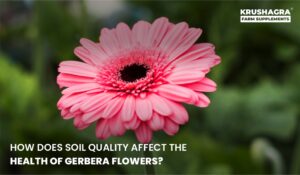How do Biofertilizers work?
Boosting soybean growth and soil health with biofertilizers for nitrogen fixation is an effective and sustainable approach to enhance crop productivity while reducing the reliance on synthetic nitrogen fertilizers. Nitrogen is a crucial nutrient for plant growth, and soybeans, like many other legumes, have the unique ability to form a symbiotic relationship with nitrogen-fixing bacteria called rhizobia.
Microorganisms such as Rhizobium, Actinobacteria, Azotobacter, and Azospirillum are present in the nitrogen-fixing biofertilizers. They facilitate the conversion of nitrate into organic molecules. One technique for transforming elemental nitrogen into a form the plants can use is biological nitrogen fixation. In the soil and root nodules of legume crops, biofertilizers fix atmospheric nitrogen and make it available to the plant. They convert phosphates including tricalcium, iron, and aluminum phosphates that are insoluble into forms that are soluble. They plunder the soil layers for phosphate.
Biofertilizers containing rhizobia are specifically designed to enhance nitrogen fixation in leguminous crops such as soybeans. These biofertilizers are applied to the soil or seed, and the rhizobia establish a mutually beneficial association with the plant roots. The rhizobia infect the root nodules and convert atmospheric nitrogen into a form that the plant can utilize for growth and development. This process is called biological nitrogen fixation.
Usage Of Biofertilizers for Nitrogen Fixing in Soybean Cultivation
Utilizing biofertilizers for nitrogen fixing is consistent with agricultural techniques that are sustainable. There are many benefits to using biofertilizers in soybean farming for nitrogen fixation, a few are mentioned below:
- Increased availability of nitrogen: Biofertilizers encourage the transformation of atmospheric nitrogen into a form that is useful to plants, ensuring a sufficient supply of nitrogen for soybean growth. This lessens the need for synthetic nitrogen fertilizers, which require a lot of energy to create and may have negative effects on the environment if used excessively.
- Improved soil health: By enriching the soil with organic matter and boosting microbial activity, biofertilizers containing rhizobia increase the health of the soil. The addition of advantageous microbes improves soil structure, inhibits dangerous diseases, and promotes the cycling of nutrients throughout the ecosystem.
- Cost-effective: While biofertilizers may initially cost more than synthetic fertilizers, using them over time can save overall input costs. Farmers can save money by using less synthetic nitrogen fertilizer while maintaining or even increasing crop yields.
- Environment friendly: Biofertilizers lessen the negative effects of excessive use of synthetic fertilizers on the environment. They support soil conservation, reduce greenhouse gas emissions, and reduce nitrogen runoff into water bodies.
Types of Biofertilizers
Depending on where they come from, biopesticides can be divided into three primary groups: microbial pesticides, plant-incorporated protectants (PIPs), and biochemical pesticides. Let’s investigate each grouping:
- Microbiological pesticides
Bacillus thuringiensis (Bt), a type of helpful bacteria that produces toxins detrimental to particular pests like some insects, is the basis of these biopesticides.
- Based on fungi: A number of fungus, including Metarhizium anisopliae and Beauveria bassiana, are employed as biopesticides to manage several fungal infections that damage plants.
- Based on viruses: Some viruses can be changed to attack and control particular pests, primarily insects. For instance, the nucleopolyhedrovirus (NPVs) are applied to caterpillars as a biopesticide.
- Plant-Incorporated Protectants (PIPs):
- Genetically Modified (GM) Crops: These are plants that have been genetically engineered to produce specific toxins derived from microbial sources. The toxins protect the plants against pests. Examples include Bt cotton and Bt corn.
- Biochemical Pesticides:
- Plant Extracts: Natural compounds extracted from plants, such as neem oil or pyrethrins from chrysanthemum flowers, are used as biopesticides to control insects.
- Pheromones: Pheromones are synthetic versions of insect sex hormones that disrupt mating patterns, confuse pests, and prevent reproduction.
- Insect Growth Regulators: (IGRs) are biopesticides that imitate insect hormones and prevent pests from growing and developing normally, hence reducing their numbers.
Conclusion
In conclusion, utilizing biofertilizers for nitrogen fixation in soybean agriculture has benefits including improved soil health, increased nitrogen availability, cost effectiveness, and conformity with sustainable agricultural practices. Due to these advantages, biofertilizers are an effective means of fostering soybean growth while avoiding negative environmental effects and decreasing reliance on synthetic fertilizers.




